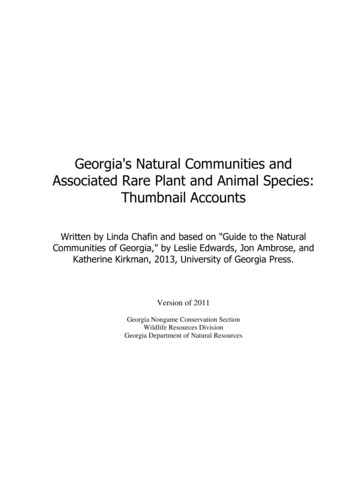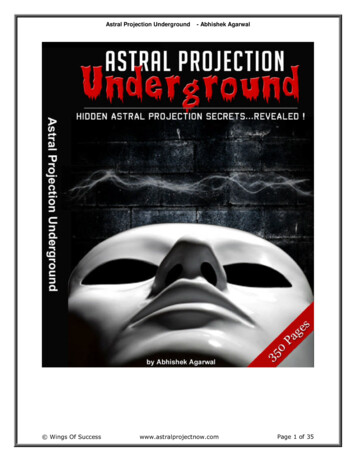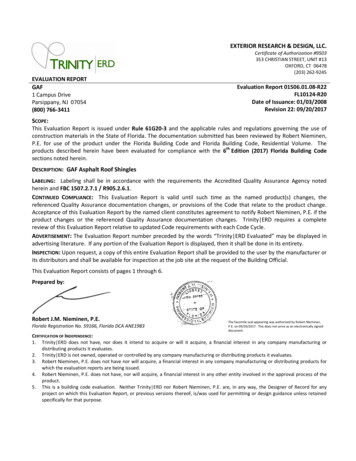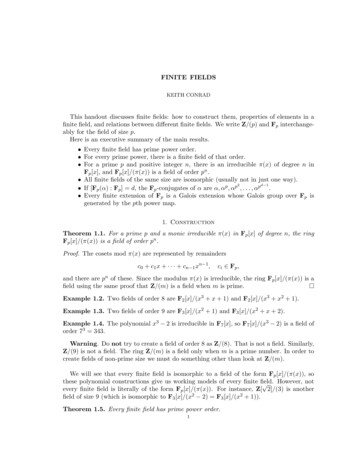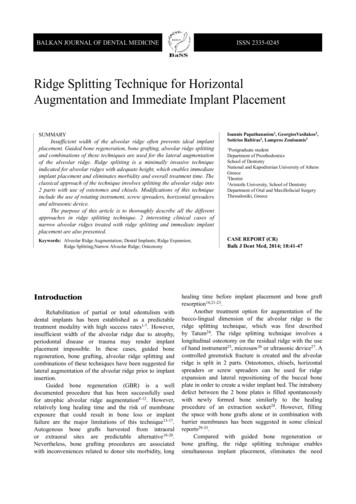
Transcription
GICAL SOCIETYBALKAN JOURNAL OF DENTAL MEDICINEISSN 2335-0245LOTOSTOMARidge Splitting Technique for HorizontalAugmentation and Immediate Implant PlacementSUMMARYInsufficient width of the alveolar ridge often prevents ideal implantplacement. Guided bone regeneration, bone grafting, alveolar ridge splittingand combinations of these techniques are used for the lateral augmentationof the alveolar ridge. Ridge splitting is a minimally invasive techniqueindicated for alveolar ridges with adequate height, which enables immediateimplant placement and eliminates morbidity and overall treatment time. Theclassical approach of the technique involves splitting the alveolar ridge into2 parts with use of ostetomes and chisels. Modifications of this techniqueinclude the use of rotating instrument, screw spreaders, horizontal spreadersand ultrasonic device.The purpose of this article is to thoroughly describe all the differentapproaches in ridge splitting technique. 2 interesting clinical cases ofnarrow alveolar ridges treated with ridge splitting and immediate implantplacement are also presented.Keywords: Alveolar Ridge Augmentation; Dental Implants; Ridge Expansion;Ridge Splitting;Narrow Alveolar Ridge; OsteotomyIntroductionRehabilitation of partial or total edentulism withdental implants has been established as a predictabletreatment modality with high success rates1-7. However,insufficient width of the alveolar ridge due to atrophy,periodontal disease or trauma may render implantplacement impossible. In these cases, guided boneregeneration, bone grafting, alveolar ridge splitting andcombinations of these techniques have been suggested forlateral augmentation of the alveolar ridge prior to implantinsertion.Guided bone regeneration (GBR) is a welldocumented procedure that has been successfully usedfor atrophic alveolar ridge augmentation8-12. However,relatively long healing time and the risk of membraneexposure that could result in bone loss or implantfailure are the major limitations of this technique13-17.Autogenous bone grafts harvested from intraoralor extraoral sites are predictable alternative18-20.Nevertheless, bone grafting procedures are associatedwith inconveniences related to donor site morbidity, longIoannis Papathanasiou1, GeorgiosVasilakos2,Sotirios Baltiras2, Lampros Zouloumis31Postgraduate studentDepartment of ProsthodonticsSchool of DentistryNational and Kapodistrian University of AthensGreece2Dentist3Aristotle University, School of DentistryDepartment of Oral and Maxillofacial SurgeryThessaloniki, GreeceCASE REPORT (CR)Balk J Dent Med, 2014; 18:41-47healing time before implant placement and bone graftresorption16,21-23.Another treatment option for augmentation of thebucco-lingual dimension of the alveolar ridge is theridge splitting technique, which was first describedby Tatum24. The ridge splitting technique involves alongitudinal osteotomy on the residual ridge with the useof hand instrument25, microsaw26 or ultrasonic device27. Acontrolled greenstick fracture is created and the alveolarridge is split in 2 parts. Osteotomes, chisels, horizontalspreaders or screw spreaders can be used for ridgeexpansion and lateral repositioning of the buccal boneplate in order to create a wider implant bed. The intrabonydefect between the 2 bone plates is filled spontaneouslywith newly formed bone similarly to the healingprocedure of an extraction socket28. However, fillingthe space with bone grafts alone or in combination withbarrier membranes has been suggested in some clinicalreports29-33.Compared with guided bone regeneration orbone grafting, the ridge splitting technique enablessimultaneous implant placement, eliminates the need
42 Ioannis Papathanasiou et al.for bone harvesting and reduces a risk of graft ormembrane exposure. Therefore, the overall treatmenttime is shortened and morbidity is reduced32,34-36. Onthe other hand, this technique can be used for horizontaldeficiencies, but not for vertical augmentation. Thus, itcan be applied for augmentation of alveolar ridges withadequate height25,36. Furthermore, the ridge splittingtechnique requires a minimum of 3mm of bucco-lingualwidth with at least 1 mm of cancellous bone betweenthe 2 cortical plates, which would allow introduction ofinstruments and the maintenance of good blood supply tothe split parts25,36-38.The purpose of this paper is to present the ridgesplitting procedure and the modified technique fromthose described in the literature. 2 interesting clinicalcases with narrow alveolar ridges treated with the ridgesplitting technique are also presented. In the first caseridge splitting was accomplished manually with the use ofosteotomes and chisels. The second case was treated witha modified splitting technique using rotating instrumentsand horizontal bone spreaders (Meisinger Crest ControlSystem).Surgical TechniquesClassical approach of ridge splitting techniqueinvolves the use of osteotomes and chisels25,30,32,39,40.Under local anaesthesia, a full-thickness mucoperiostealflap is elevated after mid-crestal and intra-crevicularincisions. A horizontal osteotomy that splits the alveolarridge in 2 segments is achieved by gently tapping thinosteotomes or chisels with a mallet. In the mandible, 2additional vertical osteotomies on the buccal bone plateare connected with the horizontal osteotomy becauseof the reduced flexibility of the mandibular corticalplates31,32,35,41. Then, a sequence of osteotomes ofincreasing size are used for the progressive expansionof the alveolar ridge until a 3 to 5 mm gap is establishedbetween the 2 segments. Twist drills are used forpreparation of the implant beds and the implants areplaced in the pre-planned positions. The space betweenthe 2 bone plates can be filled with bone grafts orallografts alone or in combination with membranes.Another ridge splitting technique includes theutilization of horizontal spreaders/expanders (MeisingerCrest Control Ridge Splitting System kit, Salvin DentalSpecialties, Charlotte, NC). Initially, a round diamond buris used to score the osteotomy site on the residual ridge.Then, a micro-saw is used for the initial osteotomy, whichis deepened by a thin cylindro-conical bur to the desireddepth. Horizontal spreaders are inserted in the osteotomy.Screw drivers open the horizontal spreaders to the finalwidth. Finally, dental implants are placed immediately42.Balk J Dent Med, Vol 18, 2014A modified splitting technique involves the use ofrotating bone spreaders38,43,44. After the initial incision ismade by the micro-saw, pilot burs create the appropriatedepth for implant placement. A series of non-cutting bonespreaders of increasing diameters are used for the gradualdensification of the cancellous bone and the expansionof the osteotomy. Dental implants can be placedsimultaneously in the pre-planned positions.Several clinical reports have referred the ultrasonicbone surgery technique17,45,46. This technique involvesultrasonic devices for creation of horizontal and verticalosteotomies in combination with the use of conventionalosteotomes for the gentle lateralization of the buccalsegment.Case AA 40-year old healthy woman presented for oralrehabilitation with fixed implant prostheses. Diagnosticcasts, diagnostic wax-ups and a radiographic/surgicaltemplate were fabricated and a dental CT scan wasperformed. Clinical and radiographic evaluation revealeda narrow alveolar ridge in the maxilla, with sufficientheight and cancellous bone between the two corticalbone plates (Fig. 1). Ridge splitting with osteotomes andchisels was planned in order to create the desired widthfor implant placement.Fig. 1. Occlusal view of the narrow maxillary alveolar ridgeFig. 2. Occlusal view after the elevation of a full-thicknessmucoperiosteal flap
Balk J Dent Med, Vol 18, 2014Fig. 3. A thin osteotome in use, creating the initial horizontal osteotomyHorizontal Augmentation and Immediate Implant Placement 43Fig.7. Immediate implant placementFig. 4. Vertical osteotomies performed with the osteotome at the mesialand distal ends of the horizontal ostetomyFig. 8. Filling of the residual gaps with allogenic bone graftFig. 5. Progressive widening of the gap between bone plates with theosteotomeFig. 9. Covering of the surgical site with a resorbable membraneFig. 6. View of the expanded maxillary alveolar ridgeUnder local anaesthesia, a mucoperiosteal flapwas elevated after a mid-crestal incision (Fig. 2). Thehorizontal osteotomy was performed by gently tapping athin osteotome with a mallet (Fig. 3). 2 additional verticalcuts were created on the buccal plate at the mesial anddistal end of the horizontal incision (Fig. 4). Osteotomesof increasing size were used for the progressivelateralization of the buccal plate (Figs. 5 and 6). Dentalimplants were placed immediately in the preoperativelyplanned positions (Fig. 7). In order to promote healing andosseointegration, the residual space between the implantsand the 2 plates was filled with allogenic bone graft
44 Ioannis Papathanasiou et al.Balk J Dent Med, Vol 18, 2014(Cells Tissuebank Austria) and covered with a resorbablemembrane (Figs. 8 and 9). The patient received 500mgamoxicillin 3 times a day for 5 days and non-steroidalanalgesics and she was advised to follow a soft diet andto use the provisional prosthesis only when necessaryfor aesthetics. A 12% chlorhexidine digluconate mouthrinse was also prescribed for 2 weeks. The implants wereallowed to heal for 6 months prior to fabrication of thefinal prosthesis.Case BA 45-year-old man presented for implant treatment inthe posterior maxilla. The evaluation of the dental CT scanrevealed that the width of the alveolar ridge was inadequatefor implant placement. A ridge splitting technique wasplanned. The Meisinger Crest Control Ridge SplittingSystem kit was used (Salvin Dental Specialties, Charlotte,NC), which consists of micro-saws, diamond burs andhorizontal bone spreaders (Fig. 10). After elevation ofa mucoperiosteal flap (Fig. 11), the initial horizontalosteotomy was performed with a micro-saw (Fig. 12).Then, a thin tapered diamond bur was used to deepenthe initial osteotomy in the desired depth according tothe implant length (Fig. 13). The horizontal spreader wasinserted in the osteotomy and was opened with a screwdriver in order to expand horizontally the alveolar ridge(Figs. 14 and 15). Twist drills were used for preparation ofthe implant beds (Fig. 16) and 2 implants were placed (Fig.17). The residual gaps were filled with allograft materialand covered by a resorbable membrane (Fig. 18).Fig. 12. Initial horizontal osteotomy created with a microsawFig. 13. Deepening of the initial osteotomy with a tapered diamond burFig. 14. Insertion of the horizontal spreaders in the osteotomyFig. 10. View of the Meisinger Crest Control Ridge Splitting kitFig. 11. Elevation of a mucoperiosteal flapFig. 15. View of the expanded ridge and the laterally repositionedbuccal plate
Balk J Dent Med, Vol 18, 2014Fig. 16. Preparation of implant bedsFig. 17. Implant placement in the pre-planned positionsFig. 18. Positioning of a resorbable membraneDiscussionHorizontal atrophy of the alveolar ridge usuallycomplicates adequate implant placement. GBR8-12, bonegrafting18-20, alveolar ridge splitting24-27 and combinationsof these techniques have been suggested as treatmentmodalities to increase bucco-lingual dimension of theresidual ridge. The ridge splitting technique is used forthe horizontal augmentation of narrow alveolar ridges andallows simultaneous implant placement. Low morbidityand short treatment time are the major advantages ofHorizontal Augmentation and Immediate Implant Placement 45this technique compared to GBR and bone graftingprocedures32,34-36.Several modifications of the ridge splitting techniquehave been described. In our clinics, ridge splitting isaccomplished either with the use of osteotomes andchisels, or with the use of special equipment such asburs, micro-saws and horizontal spreaders. Compared tothe osteotome technique, the use of spreaders providesbetter control of the amount of the expansion achieved,prevents excessive forces and patient discomfort producedby malleting43,44,47. On the other hand, the osteotometechnique eliminates the need for special equipment.Strong evidence for the effectiveness and thepredictability of the ridge splitting technique is availablein the literature. Clinical trials have reported success ratesranging from 98 to 100%. The survival rates of implantsimmediately placed in expanded sites ranged from 91%to 97.3%, while the success rates varied from 86.2% to98.8% 25,28,31,42,48.Complications during the surgical procedure are veryrare - fracture of the buccal bone plate being reportedas a major complication of the technique49. Controlledforce application and gradual expansion could preventmalfractures41,43. In addition, a thorough preoperativeevaluation is very important. The thickness of the corticalplates and the amount of the intervening cancellous bonemust be carefully assessed preoperatively by dental CTscans. Last but not least, fabrication of radiographic/surgical guide can prevent improper implant placementand angulation.In conclusion, the ridge splitting technique seemsto be a minimally invasive option for horizontalaugmentation of narrow alveolar ridges. Predictableclinical results can be achieved as long as a properpreoperative evaluation is performed and a precisesurgical protocol is followed.Acknowledgements: This paper was completed aspart of the postgraduate programme co-financed by theAct “Scholarships programme of the State ScholarshipsFoundation (IKY Scholarships) with an individualizedassessment process of the Academic Year 2012-2013”from resources of the Operational Programme “Educationand Lifelong Learning”, of the European Social Fund(ESF), the NSRF 2007-2013. The authors declare noconflicts of interest with respect to the authorship andpublication of this article.References1.Albrektsson T, Zarb G, Worthington P, Eriksson AR. Thelong-term efficacy of currently used dental implants:a review and proposed criteria of success. Int J OralMaxillofac Implants, 1986; 1:11-25.
46 Ioannis Papathanasiou et al.2.3.4.5.6.7.8.9.10.11.12.13.14.15.16.Buser D, Mericske-Stern R, Bernard JP, Behneke A,Behneke N, Hirt HP, Belser UC, Lang NP. Long-termevaluation of non-submerged ITI implants. Part 1:8-year life table analysis of a prospective multi-centerstudy with 2359 implants. Clin Oral Implants Res, 1997;8:161-172.Lekholm U, Gunne J, Henry P, Higuchi K, Lindén U,Bergström C, van Steenberghe D. Survival of the Brånemarkimplant in partially edentulous jaws: a 10-year prospectivemulticenter study. Int J Oral Maxillofac Implants, 1999;14:639-645.Leonhardt A, Gröndahl K, Bergström C, Lekholm U. Longterm follow-up of osseointegrated titanium implants usingclinical, radiographic and microbiological parameters. ClinOral Implants Res, 2002; 13:127-132.Lindquist LW, Carlsson GE, Jemt T. A prospective 15-yearfollow-up study of mandibular fixed prostheses supportedby osseointegrated implants. Clinical results and marginalbone loss. Clin Oral Implants Res, 1996; 7:329-336.van Steenberghe D. A retrospective multicenter evaluationof the survival rate of osseointegrated fixtures supportingfixed partial prostheses in the treatment of partialedentulism. J Prosthet Dent, 1989; 61:217-223.Weber HP, Crohin CC, Fiorellini JP. A 5-year prospectiveclinical and radiographic study of non-submerged dentalimplants. Clin Oral Implants Res, 2000; 11:144-153.Buser D, Brägger U, Lang NP, Nyman S. Regeneration andenlargement of jaw bone using guided tissue regeneration.Clin Oral Implants Res, 1990; 1:22-32.Nevins M, Mellonig JT, Clem DS 3rd, Reiser GM, BuserDA. Implants in regenerated bone: long-term survival. Int JPeriodontics Restorative Dent, 1998; 18:34-45.Brunel G, Brocard D, Duffort JF, Jacquet E, JustumusP, Simonet T, Benqué E. Bioabsorbable materials forguided bone regeneration prior to implant placement and7-year follow-up: report of 14 cases. J Periodontol, 2001;72:257-264.Hämmerle CH, Jung RE. Bone augmentation by means ofbarrier membranes. Periodontol 2000, 2003; 33:36-53.Jung RE, Lecloux G, Rompen E, Ramel CF, Buser D,Hammerle CH. A feasibility study evaluating an in situformed synthetic biodegradable membrane for guidedbone regeneration in dogs. Clin Oral Implants Res, 2009;20:151-161.Machtei EE. The effect of membrane exposure on theoutcome of regenerative procedures in humans: a metaanalysis. J Periodontol, 2001; 72:512-516.Nyström E, Ahlqvist J, Kahnberg KE, Rosenquist JB.Autogenous onlay bone grafts fixed with screw implants forthe treatment of severely resorbed maxillae. Radiographicevaluation of preoperative bone dimensions, postoperativebone loss, and changes in soft-tissue profile. Int J OralMaxillofac Surg, 1996; 25:351-359.Nevins M, Mellonig JT. Enhancement of the damagededentulous ridge to receive dental implants: a combinationof allograft and the GORE-TEX membrane. Int JPeriodontics Restorative Dent, 1992; 12:96-111.Chiapasco M, Abati S, Romeo E, Vogel G. Clinical outcomeof autogenous bone blocks or guided bone regenerationwith e-PTFE membranes for the reconstruction of narrowedentulous ridges. Clin Oral Implants Res, 1999; 10:278-288.Balk J Dent Med, Vol 18, 201417. Blus C, Szmukler-Moncler S. Split-crest and immediateimplant placement with ultra-sonic bone surgery: a 3-yearlife-table analysis with 230 treated sites. Clin Oral ImplantsRes, 2006; 17:700-707.18. Lekholm U, Wannfors K, Isaksson S, Adielsson B. Oralimplants in combination with bone grafts. A 3-yearretrospective multicenter study using the Brånemark implantsystem. Int J Oral Maxillofac Surg, 1999; 28:181-187.19. Chiapasco M, Romeo E, Vogel G. Tridimensionalreconstruction of knife-edge edentulous maxillae by sinuselevation, onlay grafts, and sagittal osteotomy of the anteriormaxilla: preliminary surgical and prosthetic results. Int JOral Maxillofac Implants, 1998; 13:394-399.20. Bahat O, Fontanessi RV. Efficacy of implant placementafter bone grafting for three-dimensional reconstruction ofthe posterior jaw. Int J Periodontics Restorative Dent, 2001;21:220-231.21. Felice P, Pistilli R, Lizio G, Pellegrino G, Nisii A, MarchettiC. Inlay versus onlay iliac bone grafting in atrophicposterior mandible: a prospective controlled clinical trial forthe comparison of two techniques. Clin Implant Dent RelatRes, 2009; 11:e69-82.22. Schwartz-Arad D, Levin L, Sigal L. Surgical success ofintraoral autogenous block onlay bone grafting for alveolarridge augmentation. Implant Dent, 2005; 14:131-138.23. Hodges NE, Perry M, Mohamed W, Hallmon WW, Rees T,Opperman LA. Distraction osteogenesis versus autogenousonlay grafting. Part II: biology of regenerate and onlaybone. Int J Oral Maxillofac Implants, 2006; 21:237-244.24. Tatum H Jr. Maxillary and sinus implant reconstructions.Dent Clin North Am, 1986; 30:207-229.25. Sethi A, Kaus T. Maxillary ridge expansion withsimultaneous implant placement: 5-year results of anongoing clinical study. Int J Oral Maxillofac Implants,2000; 15:491-499.26. Suh JJ, Shelemay A, Choi SH, Chai JK. Alveolar ridgesplitting: a new microsaw technique. Int J PeriodonticsRestorative Dent, 2005; 25:165-171.27. Blus C, Szmukler-Moncler S, Vozza I, Rispoli L, Polastri C.Split-crest and immediate implant placement with ultrasonicbone surgery (piezosurgery): 3-year follow-up of 180 treatedimplant sites. Quintessence Int, 2010; 41:463-469.28. Bravi F, Bruschi GB, Ferrini F. A 10-year multicenterretrospective clinical study of 1715 implants placed withthe edentulous ridge expansion technique. Int J PeriodonticsRestorative Dent, 2007; 27:557-565.29. Koo S, Dibart S, Weber HP. Ridge-splitting technique withsimultaneous implant placement. Compend Contin EducDent, 2008; 29:106-110.30. Elian N, Jalbout Z, Ehrlich B, Classi A, Cho SC, Al-KahtaniF, Froum S, Tarnow DP. A two-stage full-arch ridgeexpansion technique: review of the literature and clinicalguidelines. Implant Dent, 2008; 17:16-23.31. Engelke WG, Diederichs CG, Jacobs HG, Deckwer I.Alveolar reconstruction with splitting osteotomy andmicrofixation of implants. Int J Oral Maxillofac Implants,1997; 12:310-318.32. Enislidis G, Wittwer G, Ewers R. Preliminary report on astaged ridge splitting technique for implant placement in themandible: a technical note. Int J Oral Maxillofac Implants,2006; 21:445-449.
Balk J Dent Med, Vol 18, 201433. Simion M, Baldoni M, Zaffe D. Jawbone enlargement usingimmediate implant placement associated with a split-cresttechnique and guided tissue regeneration. Int J PeriodonticsRestorative Dent, 1992; 12:462-473.34. Han JY, Shin SI, Herr Y, Kwon YH, Chung JH. The effectsof bone grafting material and a collagen membrane in theridge splitting technique: an experimental study in dogs.Clin Oral Implants Res, 2011; 22:1391-1398.35. Piccinini M. Mandibular bone expansion technique inconjunction with root form implants: a case report. J OralMaxillofac Surg, 2009; 67(9):1931-1936.36. Demarosi F, Leghissa GC, Sardella A, Lodi G, CarrassiA. Localised maxillary ridge expansion with simultaneousimplant placement: a case series. Br J Oral Maxillofac Surg,2009; 47:535-540.37. Dene L, Condos S. Ridge expansion and immediate implantplacement in the esthetic zone. N Y State Dent J, 2010;76:28-31.38. Chan HL, Fu JH, Koticha T, Benavides E, Wang HL. Ridgewidth gain with screw spreaders: a cadaver study. ImplantDent, 2013; 22:552-558.39. Scipioni A, Calesini G, Micarelli C, Coppè S, Scipioni L.Morphogenic bone splitting: description of an originaltechnique and its application in esthetically significant areas.Int J Prosthodont, 2008; 21:389-397.40. Strietzel FP, Nowak M, Küchler I, Friedmann A. Periimplant alveolar bone loss with respect to bone quality afteruse of the osteotome technique: results of a retrospectivestudy. Clin Oral Implants Res, 2002; 13:508-513.41. Sohn DS, Lee HJ, Heo JU, Moon JW, Park IS, Romanos GE.Immediate and delayed lateral ridge expansion technique inthe atrophic posterior mandibular ridge. J Oral MaxillofacSurg, 2010; 68:2283-2290.42. Chiapasco M, Ferrini F, Casentini P, Accardi S, ZaniboniM. Dental implants placed in expanded narrow edentulousridges with the Extension Crest device. A 1-3-yearHorizontal Augmentation and Immediate Implant Placement 4743.44.45.46.47.48.49.multicenter follow-up study. Clin Oral Implants Res, 2006;17(3):265-272.Siddiqui AA, Sosovicka M. Lateral bone condensing andexpansion for placement of endosseous dental implants: anew technique. J Oral Implantol, 2006; 32(2):87-94.Nishioka RS, Souza FA. Bone spreader technique: apreliminary 3-year study. J Oral Implantol, 2009; 35:289-294.Anitua E, Begoña L, Orive G. Clinical evaluation of splitcrest technique with ultrasonic bone surgery for narrowridge expansion: status of soft and hard tissues and implantsuccess. Clin Implant Dent Relat Res, 2013; 15:176-187.Anitua E, Begoña L, Orive G. Controlled ridge expansionusing a two-stage split-crest technique with ultrasonic bonesurgery. Implant Dent, 2012; 21:163-170.Peñarrocha M, Pérez H, Garciá A, Guarinos J. Benignparoxysmal positional vertigo as a complication ofosteotome expansion of the maxillary alveolar ridge. J OralMaxillofac Surg, 2001; 59:106-107.Scipioni A, Bruschi GB, Calesini G. The edentulous ridgeexpansion technique: a five-year study. Int J PeriodonticsRestorative Dent, 1994; 14:451-459.Chiapasco M, Zaniboni M, Boisco M. Augmentationprocedures for the rehabilitation of deficient edentulousridges with oral implants. Clin Oral Implants Res, 2006;17:136-159.Correspondence and request for offprints to:I. Papathanasiou, DDS, Postgraduate studentDepartment of Prosthodontics, School of Dentistry, University of Athens,Greece4 Kardaritsiou streetGlyka NeraAthens 15354GreeceE-mail: b-jon-papatha@hotmail.com
healing time before implant placement and bone graft resorption16,21-23. Another treatment option for augmentation of the bucco-lingual dimension of the alveolar ridge is the ridge splitting technique, which was first described by Tatum24. The ridge splitting technique involves a longitudinal osteotomy on the residual ridge with the use

